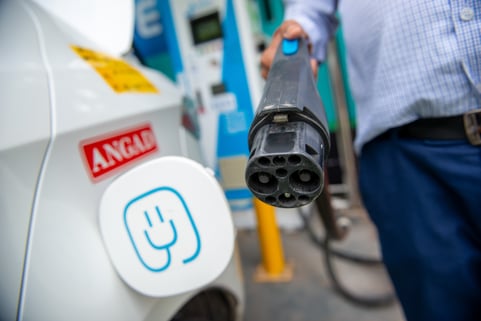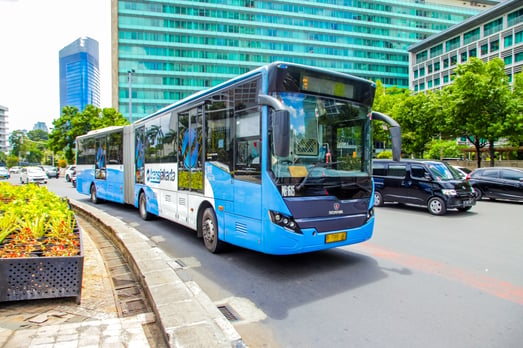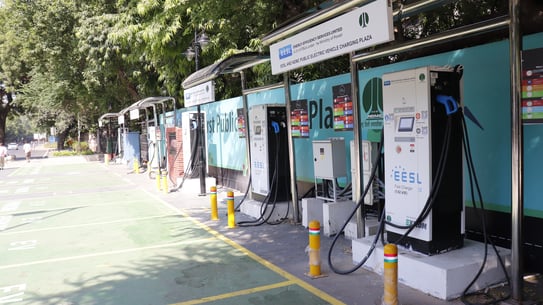Decarbonising transport on a large scale requires shifting how we perceive public services in order to make positive moves towards sustainability milestones. In Asia, this change in thinking has been progressed by policymaking with a specific focus on the power of electric mobility. So, what has been done so far to reach this point for electrification of transport in Asia?
The transport sector is a major contributor of greenhouse gas emissions and directly links to higher levels of air pollution within densely populated urban areas. So, whenever people discuss sustainability within infrastructure, e-mobility needs to be a central pillar to that conversation.
Making the switch to sustainable modes of transport within communities can have a wide range of uplifting effects, creating a more equitable, accessible, and cleaner future – something the UK PACT Green Recovery Challenge Fund strives for.
The benefits of electrifying public transport
Reducing transport emissions, especially in public transport, have a number of key benefits, including:
- improve air quality
- reduce noise pollution in busy areas
- create better services for residents
- catalyse the modernisation of transport networks
Efforts already being made within Asia, such as the Smart City Mission in India, have highlighted how crucial advancements within electric vehicle (EV) policy are to achieving impactful progress toward long-term sustainable changes. These benefits are typically felt most by lower-income groups or communities, as they are the ones who suffer from excess transport emissions.
Recent work undertaken by organisations such as the Institute of Transport & Development Policy and Research Triangle India has demonstrated how policy changes have led to tangible progress towards these goals, like localised increases in EV uptake. Plus, switching on sustainable thinking will drive other efficiencies such as improvements to quality of life within local communities, cohesive green strategies, and promoting awareness of Gender Equality and Social Inclusion (GESI) accessibility at the same time.
The obstacles to implementation
Focusing specifically on e-mobility efforts across Asia, the main obstacle isn’t necessarily acquiring the relevant electric vehicles – but rather the processes and policies required to put them into practice. Here are just a few of the obstacles that need to be overcome as part of the low-carbon transition, exemplified by the countries making efforts to do so.
Speed of uptake
UK PACT is supporting Ricardo PLC to analyse the Bangladesh EV market and improve the uptake of electric two-wheelers. Their analysis found that Bangladesh has the highest potential for upscaling electric two-wheeler production since motorcycle usage is incredibly high − with 80% manufactured or assembled locally. This manufacturing potential carries over to 4-wheeler EVs as well, where uptake has been relatively low so far.
Ricardo PLC also reviewed current EV regulations, created by the Government of Bangladesh (GoB) in 2018 for the Road Transport and Bridget Ministry, which were created to address the barriers to EV uptake, including the need to regulate the EV market. The regulations include a combination of uptake incentives and the creation of solar powered charging stations which have help to further EV infrastructure development.
By gaining a deeper understanding of the Bangladesh EV market, including the existing measures and policies in place, Ricardo PLC has identified the primary challenges facing the EV market. Tackling these challenges will provide the framework for a new roadmap that addresses the key remaining barriers, such as bureaucratic red-tape preventing progressive policy implementation and an absence of incentives, which will likely improve the uptake speed.
 Making equality part of the equation
Making equality part of the equation
While the practical side of electric transformation will greatly benefit those who frequently use public transport services, there are lessons already being learnt to ensure services are accessible for those most reliant on them.
UK PACT is currently supporting the Institute for Transportation & Development Policy (ITDP) in Indonesia to build capacity and develop an action plan for scaling up Transjakarta e-buses in the city of Jakarta. ITDP considered all barriers to service to ensure the action plan for e-buses addresses a wider set of issues and will better support those who need them most.
ITDP reviewed areas such as the current fleet's high floors and small doorways, which could affect those with physical disabilities, as well looking at how services could be difficult to use for people with sensory impairments.
The Transjakarta workforce was also taken into consideration within this review. ITDP’s findings showed that only 14.3% of staff are female, and there is only one female field officer within the Transjakarta workforce. Therefore, part of the action plans needed to include a gender responsive and inclusive element to increase the share of female workers, allowing for a wider perspective of views within Transjakarta.
Incentivising the swap to electric two-wheelers
Cost to the individual is one of the biggest inhibitors to behaviour shifts. As part of the research being carried out by ITDP in Jakarta, the institute also reviewed how India grew their EV ecosystem to help inform the design of possible best practice models for Transjakarta in Indonesia.
In India, two-wheelers account for 70% of the 200 million plus registered vehicles (MOSPI, 2017), representing a major portion of the government’s goal to make 30% of total vehicles electric by 2030. As a result, Phase 1 of the Faster Adoption and Manufacturing of (Hybrid &) Electric Vehicles (FAME I) governmental scheme launched in 2015 to accelerate EV adoption under the National Electric Mobility Mission Plan 2020 (MHIPE, 2012).
FAME I offers combined fiscal incentives for switching to electric two-wheelers, such as subsidies, free scrapping, and road tax exemptions but there are additional non-fiscal incentives as well, such as toll waivers and dedicated parking spots, with future plans aiming to include dedicated EV parking in every major public area. These fiscal incentives total 20.2% toward the total EV cost, but there are additional non-fiscal incentives as well, such as toll waivers and dedicated parking spots, with future plans aiming to include dedicated EV parking in every major public parking area. Toll waivers and dedicated parking spots, as well as future plans to expand dedicated parking to every major public parking area, were included as incentives.
The result? Around 90% of the vehicles that took up FAME I’s incentives were electric two-wheelers (CRISIL Research, 2019). FAME I’s approach was integrated into ITDP’s best practice guidance for Transjakarta detailing how other countries could emulate elements of FAME I in order to have similar success when integrating new EV policies.
How UK PACT supports these transitions 
UK PACT is supporting all of these fantastic projects. The recent Electrifying Urban Mobility window, delivered through the Green Recovery Challenge Fund, is a demonstration of this support in action. By engaging with UK PACT, a wide portfolio of projects have made great strides forward in overhauling e-mobility policy within local government, bringing them closer to their goals.
These examples aren’t exhaustive either – UK PACT funding has also provided planning support, covering areas such as faster uptake of electric vehicles within public transport, redesigning networks for better efficiency, and developing sustainable business models or green procurement strategies – each representing a step towards a low-carbon future.
Climate change is a critical issue that spans the globe, meaning that fundamental changes need to be made everywhere – and imminently. The pandemic provides a pivotal moment to re-assess past transportation policies and practices and course-correct to align with ambitious climate targets. UK PACT welcomes opportunities to advance a vision for a more equitable, accessible and cleaner low-carbon transport system.
|
You can find out more about how UK PACT is supporting e-mobility efforts worldwide in our recent e-mobility webinar here. |
About the author:
 Fernanda Samman is an experienced consultant across energy storage, electric vehicles, life cycle assessment, sustainability, and corporate social responsibility.
Fernanda Samman is an experienced consultant across energy storage, electric vehicles, life cycle assessment, sustainability, and corporate social responsibility.
She has worked in Mexico, Spain and the UK developing corporate social responsibility projects, verified sustainability reports, supported the development of carbon footprint projects, and undertaken social risk assessments for energy projects.
Fernanda has also provided support on the design and construction of public charging stations for leading electric vehicle manufacturers, as well as the development of utility-scale and C&I battery energy storage systems projects to examine the viability of including further renewable energy generation resources within the network.
The views expressed in this blog are the author's own personal views, not an official position of UK PACT.
